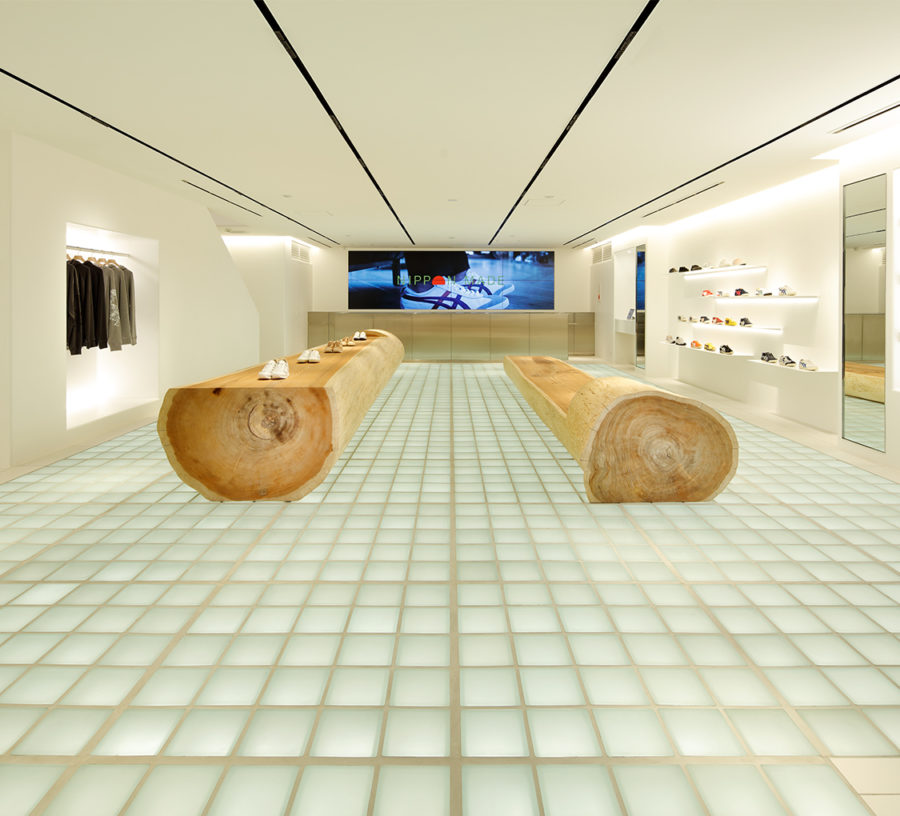農家のお屋敷や蔵が残る古い町並みと、その田畑を宅地開発した新興住宅地の境目にこの住宅は位置している。周囲の古い家屋の屋根は独特の赤褐色で知られる石州瓦で葺かれ、山陰の集落らしい景観を形成しているが、新しい住宅街にその姿はない。
石州瓦に魅せられた私たちは、この瓦の魅力を最大限に活かす屋根をテーマに、2つのエリアの境界を馴染ませるような住宅を目指した。
敷地の広い間口をいかした長い瓦屋根は、雪が留まらないよう存在感のある勾配を確保しつつも周囲に圧迫感を与えないよう寄棟とし、軒先は手が届きそうなくらい低く延ばして親しみやすさを意識した。
近年は鉛が使用禁止になり、釉薬も限られてしまい瓦の色も形も均一化されてしまっているため、今回は色味や艶が異なる3種類の瓦を混ぜ葺きすることで、周囲の古瓦が経年変化で赤・茶・黒が入り混じっているような豊かな表情の屋根を目指した。
おおよそ平面の中心に配置された2階のボリュームの屋根・壁はガルバリウム鋼板で4種類の幅を混ぜた縦ハゼ葺きとして、ハゼ締めの手作業が生む歪みによる柔らかい表情を取り込んだ。
溶融亜鉛メッキのエキスパンドメタルのフェンスは角度によって通行人の視界に変化を生じさせるとともに、経年によって植物が建物の外観を変容していく余白になっている。
老夫婦のためのこの住まいは、1階部分のみで生活が完結し、寝室を動線の中心に据えたプランとした。寝室とリビングダイニングは吹き抜けに向けて伸び上がる大きな棚で区切られているが、ガラス越しに気配を感じたり、小扉を開けて声がけができたりと、コミュニケーションが取りやすい仕掛けを施している。
直上の吹き抜け空間は1日中自然光が降り注ぐ光のポケットになっていて、カーテンを透過した光の揺らぎや壁の上を賑わす影は時間の移ろいを知らせてくれる。
敷地西端の中庭と玄関はオープンな空間として位置づけ、ピアノが置かれた広い玄関土間はときどきサロンとして人が集まることを想定している。
日常的な出入りは東端のガレージから、風除室と物干し場を兼ねたサンルームを通る。一部にガラス瓦を混ぜ葺きして、光を取り込んでいる。躯体はむき出し、瓦の裏側までもが見え、フラッシュドアは中の構造が露わになったプリミティブなつくりとしている。
地域性の色濃く残る古い家屋と、どこにでもある住宅街を一瞬にしてつくり出す工業製品化された住宅。その世代間のギャップを埋めるかのように、工業製品を採用しながらもその中に積極的に取り入れた「ムラ」がこの住宅を特徴づけている。
雨と雪に強いガラス質の表面は玉虫色のように多彩に表情を変化させ、山陰地方の曇りがちな空によく映えている。(桶川容子)
Housing that fills the gap between multiple townscapes and generations
The site is located on the border between an old town and a new residential area.
The roofs of the surrounding old houses are covered with Sekishu tiles, known for their unique reddish-brown color, forming a landscape typical of a village in the San-in region but not seen in the new residential area.
Fascinated by the Sekishu tiles, we proposed a house that blends the boundary between the two areas with the theme of a roof that maximizes the appeal of these tiles.
The long roof, which takes advantage of the wide frontage of the site, has a strong slope to prevent snow from settling on the roof. On the other hand, the roof is hipped so as not to give an oppressive feeling to the surroundings.
In recent years, the use of lead has been banned, and glazes have been limited, so the color and shape of tiles have become uniform.
The roof and walls of the second-floor volume, located roughly in the center of the plan, are made of galvanized steel sheet with four different widths of vertical haze-thatched roofing, incorporating the soft expression of distortion created by the manual haze-tightening process.
The hot-dip galvanized expanded metal changes the view for passersby depending on the angle and also provides a margin for plants to transform the appearance of the building over time.
The plan of this house for an elderly couple is to complete their life only on the first floor, with the bedroom at the center of the house. The bedroom and the living/dining room are separated by a large shelf that extends toward the double-height ceiling, but it is easy to communicate with each other by feeling the presence of others through the glass or by opening a small door.
The void space is a pocket of natural light that pours in throughout the day, and the flickering light through the curtains and the shadows on the walls indicate the passage of time.
The courtyard and entrance at the west end of the site are positioned as an open space, and the large entrance hall with a piano is intended to be used as a salon for occasional gatherings.
Daily access to the house is through the garage at the east end and the sunroom, which also serves as a windbreak and drying area. The sunroom is partially covered with a mixture of glass tiles to let in light. The frame of the building is bare, even the underside of the tiles is visible, and the flush doors are primitive, revealing the structure inside.
Old houses with strong regional characteristics and industrialized houses instantly create typical suburban residential areas. As if to bridge the gap between the two generations, this house is characterized by the “unevenness” that is actively incorporated into the industrial products used.
The glassy surface, which is resistant to rain and snow, changes its expression in a variety of ways, like iridescent colors, and is well reflected in the cloudy sky of the San-in region. (Yoko Okegawa)
【mimosa house】
所在地:鳥取県鳥取市
用途:戸建住宅
クライアント:個人
竣工:2020年
設計:marutau arqui
担当:桶川容子、東 裕
植栽:山陰園芸センター ピアンタ・ピアット
施工:ジューケン
撮影:藤井浩司、池本喜巳、marutau arqui
工事種別:新築
構造:木造
規模:地上2階
敷地面積:353.19m²
建築面積:165.41m²
延床面積:199.81m²
設計期間:2018.04-2018.11
施工期間:2019.02-2020.09
【mimosa house】
Location: Tottori-shi, Tottori, Japan
Principal use: Residential
Client: Individual
Completion: 2020
Architects: marutau arqui
Design team: Yoko Okegawa, Yu Azuma
Planting: pianta-piatto
Contractor: JUKEN
Photographs: Koji FUJII / Yoshimi IKEMOTO / marutau arqui
Construction type: New building
Main structure: Wood
Building scale: 2 stories
Site area: 353.19m²
Building area: 165.41m²
Total floor area: 199.81m²
Design term: 2018.04-2018.11
Construction term: 2019.02-2020.09








